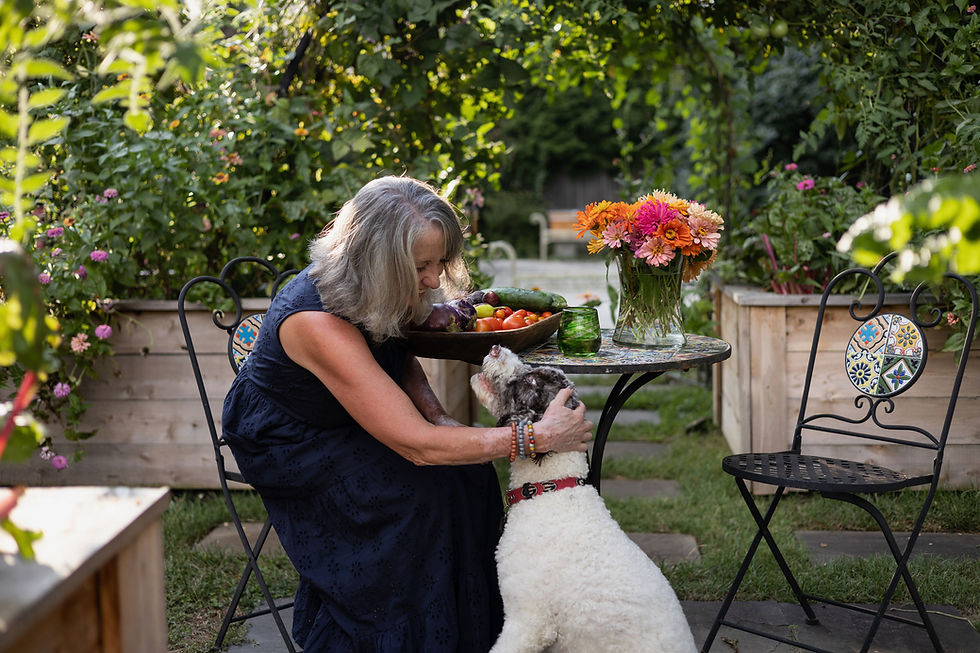Garden Exercises: The Natural Workout Perfect for Seniors and Beyond
- Sara Rubens

- May 8
- 4 min read
Let's be honest, if you've ever lifted a compost bag, pulled weeds for 30 minutes, or hauled a hose across the yard…
You've already done your workout for the day. 😉
We don't often think of gardening as exercise, but it absolutely is. In fact, gardening might be one of the most beneficial forms of physical activity for older adults looking to stay active without the strain of traditional workouts.
It builds strength, improves balance, boosts flexibility, and gets you moving—without the gym, the machines, or the monthly membership.
The best part?
You're not just getting stronger.
You're growing something that gives back—again and again. 🌿

Why Gardening Exercise Works Especially Well for Seniors
As we age, high-impact exercises can become challenging or even risky. The gentle, varied movements of gardening provide an excellent alternative that's both effective and enjoyable. Studies show that regular gardening can help seniors maintain mobility, reduce the risk of falls, and even slow cognitive decline.
According to research from Kansas State University, gardening is considered moderate-intensity exercise—burning between 200-400 calories per hour while working all the major muscle groups.
For older adults seeking to maintain independence and mobility, these garden exercises offer the perfect blend of functionality and pleasure.
The Hidden Benefits of Garden Workouts
Gardening exercise offers unique advantages that traditional workouts simply can't match:
Joint-friendly movements: Most gardening tasks involve gentle, natural motions that don't stress aging joints
Variable intensity: You can easily adjust your pace and effort level based on how you're feeling that day
Meaningful activity: Exercise feels less like a chore when you're creating something beautiful or growing your own food
Vitamin D boost: Outdoor gardening provides natural sunlight exposure, supporting bone health and mood regulation
Connection with nature: Research shows time in green spaces reduces stress hormones and blood pressure
For seniors especially, this combination of physical activity and nature connection creates a powerful wellness boost that supports both physical and mental health.
💪 A Gardener's Full-Body Workout (Without the Workout Clothes)
Try these fun gardening "workouts" next time you're outside—no mat or dumbbells required:
For Lower Body Strength
✅ Weeding squats – Instead of bending over, drop into a gentle squat. It works your legs and protects your back. For older gardeners, this technique is particularly valuable for reducing strain on the lower back while strengthening quadriceps that support knee stability.
✅ Watering lunges – Step and bend as you move from plant to plant. It's a great way to stretch while staying active. The slight weight of a watering can adds just enough resistance to build strength without overexertion.
For Upper Body and Core
✅ Wheelbarrow push-pulls – Pushing a full wheelbarrow or bag of soil builds upper body strength and improves endurance. For seniors, start with lighter loads and gradually increase as strength improves.
✅ Shovel & rake reps – These repetitive movements engage your arms, shoulders, and core—hello, functional fitness! The natural resistance of soil provides perfect moderate resistance training.
For Balance and Coordination
✅ Stepping stone paths – Walking carefully along garden paths improves balance and spatial awareness—crucial skills for preventing falls in older adults.
✅ Reaching and pruning – Strategic trimming exercises shoulder mobility and core stability as you reach for different branches.
You don't need to count reps—you'll feel it in the best way.
Making Garden Exercise Safe and Accessible for All Ages
While gardening offers tremendous benefits for seniors, a few simple modifications can make it even safer and more enjoyable:
Raised beds and vertical gardens reduce the need for bending and kneeling—perfect for those with mobility challenges
Ergonomic tools with padded handles and longer shafts minimize strain on arthritic joints
Garden stools or kneelers provide support and make it easier to transition between sitting and standing
Morning or evening gardening avoids peak sun hours, reducing heat stress and sunburn risk
Hydration stations placed throughout the garden encourage regular water breaks
With these adaptations, garden exercise becomes accessible to virtually everyone, regardless of age or fitness level.

Creating Your Garden Exercise Routine
The beauty of gardening for fitness is that it follows the natural rhythms of the seasons, providing different types of exercise throughout the year:
Spring: More cardio as you prepare beds and plant (digging, raking)
Summer: Regular moderate activity with watering, weeding, and harvesting
Fall: Strength work with clearing, mulching, and preparing for winter
Winter: Planning and indoor seedling care (fine motor skills)
For older gardeners especially, this variety prevents workout boredom while naturally matching activity levels to energy and weather conditions.
Start Your Garden Fitness Journey Today
Whether you're 65, 85, or anywhere in between, gardening offers a sustainable, enjoyable way to stay physically active. The combination of meaningful activity, connection with nature, and gentle yet effective exercise makes it perhaps the perfect workout for seniors.
So next time someone asks about your exercise routine, feel free to proudly point to your thriving garden beds. You're not just growing plants—you're cultivating strength, balance, flexibility, and joy with every seed you sow and every weed you pull.
Remember: The most sustainable exercise is the kind you actually enjoy doing. And for many seniors, there's nothing more enjoyable than watching your garden—and your health—flourish together.
Ready to get started with garden exercise? Begin small with just 15-30 minutes of gentle gardening activity, and gradually increase as your strength and stamina improve. Your body (and your garden) will thank you!




Comments